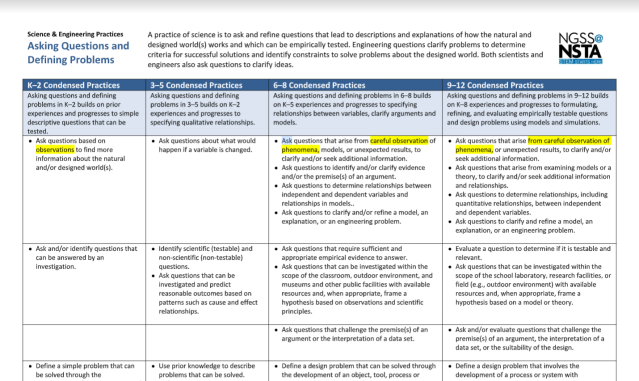This weekend I was working with a teacher preparing for the first week of school. This teacher has been thinking a lot about three-dimensional instruction and the vision articulated in A Framework for K-12 Science Education since his state adopted new state standards based on the Framework. Before his state adoption, he had consistently kicked off the school year with a demo embedded below. This coaching moments blog focuses on a teacher’s evolving understanding and road to expertise as he translates the Framework vision into classroom teaching and learning.
“The mind is entertained by the unusual, the different, and the new.”
Andy Puddicombe, Headspace
On the first day of school in this teacher’s district, students only spent about 20 minutes in each period. He loved how curious and interested students were in the discrepant event embedded above. It just felt right to him as a great way to kick off the year in a science classroom. Last year, he had started learning more about the science and engineering practices with his new state adoption. He noticed the mention of phenomena and use of observations as a foundation to begin the sensemaking process embedded throughout the elements of the science and engineering practices in appendix f of the Next Generation Science Standards. With this new understanding, he added a focus on observations and inferences to his first activity with the goal of supporting students in being able to make careful, accurate and complete observations of phenomena in order to engage in the science and engineering practices. (Read more about his first iteration of the activity here).

Since last fall, this teacher has evolved his understanding even further about the role of phenomena in a three-dimensional classroom. This weekend our conversations included a-ha moments about how phenomena in this new Framework vision have many essential attributes. They are engaging and evoked curiosity in kids (the gut feeling he experienced for years with this kick-off activity). Phenomena empower students by becoming a rich context for their own questions (careful, complete, and accurate observations of phenomena increase the probability for good questions). Phenomena are the context for both the scientist and the engineer because they can be explained with science ideas. This last attribute, the science ideas needed to explain the phenomenon, was the new understanding that this teacher wanted to add to the activity this year. He wanted his students to start the year understanding how phenomena and their questions would drive learning in this classroom, and how phenomena will be the context for learning because we need science to explain them (and answer the questions we generated). His evolving understanding of the role of phenomena can be evidenced in his iteration of this kick-off activity, from fun engaging event to a trajectory for the year and an establishment of the culture of learning in this classroom:
“It is the phenomenon plus the student-generated questions about the phenomenon that guide the learning and teaching”
Using Phenomena in the NGSS resource from Achieve
In our conversations, we referred often to the resource linked above to deepen our understanding of phenomena and their critical role in the new vision for science education. Coaching conversations using classroom experiences and third-point references and resources have resulted in this evolution of understanding. How have you changed your thinking about phenomena and its focus in your classroom?
